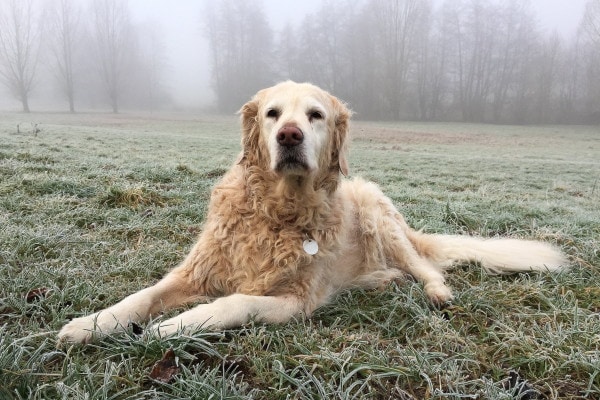Degenerative myelopathy in dogs is a progressive and incurable neurologic condition that leads to paralysis. It certainly isn’t a diagnosis any dog parent would want to receive. So you can better advocate for your beloved companion, integrative veterinarian Dr. Julie Buzby shares the causes, signs, stages, diagnosis, treatment, and prognosis of degenerative myelopathy. Plus, she provides caring guidance on when to euthanize a dog with degenerative myelopathy.

If your beloved dog just received a diagnosis of degenerative myelopathy (or DM has been put on the table as a potential diagnosis), your head might be reeling as you wonder what the future may hold. It can be scary and overwhelming to consider, not to mention, beyond heartbreaking.
While knowing more about canine degenerative myelopathy can’t change the ultimate outcome, it can prepare you for the journey. And hopefully having a better idea of what to expect and how to help your canine companion each step of the way will give you some measure of comfort and strength. So let’s get started and walk this road together.
What is degenerative myelopathy in dogs?
Degenerative myelopathy (DM) is a degenerative disease in dogs that affects the white matter (i.e. the long axons or “arms” of a nerve cell that transmit signals) in the spinal cord. Sometimes, it is also called German Shepherd degenerative myelopathy or chronic degenerative radiculomyelopathy. Also, as it turns out, degenerative myelopathy in dogs is very similar to the human disease amyotrophic lateral sclerosis (also known as ALS or Lou Gehrig’s Disease).
DM in dogs begins in the T3 to L3 portion of the spinal cord. This is the area of the spinal cord contained within the third thoracic (chest) vertebrae to the third lumbar (back) vertebrae. This particular region of the spinal cord is responsible for sending signals from the brain to the nerves controlling the back legs.
Therefore, initially dogs may have weakness of the hind limbs. But eventually the disease progresses to involve all of the spinal cord. At this point, DM also affects the dog’s ability to breathe, swallow, and use his or her front legs.
What are the stages of degenerative myelopathy in dogs and which symptoms accompany each stage?
While the speed of progression of degenerative myelopathy can be variable, dogs generally develop symptoms in a particular order. Therefore, researchers divide degenerative myelopathy into stages. There are both four-stage and five-stage classification systems. But here we will use the four-stage system.
Stage 1: Early signs of DM
As mentioned, DM in dogs initially affects the portion of the spinal cord that relays messages to the hind limbs. So the early clinical signs of DM in dogs will all involve the rear legs. In Stage 1, you might notice:
- Increased difficulty standing up after lying down
- The dog’s hips swaying back and forth when walking or standing still
- Crossing of the hind legs when walking or standing
- Abnormal gait or the dog “walking funny”
- Dog’s back legs collapsing or looking wobbly
At this stage, sometimes the signs might be more dramatic in the left leg than the right (or vice versa). The dog is still able to get around from place to place, but has more difficulty walking. And when the vet tests the dog’s spinal reflexes, they will still be present.

In dogs who are first developing the disease, their symptoms can look a lot like those of hip dysplasia in dogs or osteoarthritis in dogs. This can make it difficult to know if this is DM verses arthritis or another orthopedic condition.
But as degenerative myelopathy progresses, the symptoms begin to look different. Unlike dogs with arthritis, dogs with DM will have neurological changes. For example, affected dogs can have knuckling in dogs (or folding over) of the hind limbs or paws. This leads to the dog wearing down the toenails and scuffing the top of the paws.
Generally, dogs may be in stage 1 for the first 6 to 12 months of the disease course. But this can vary from dog to dog.
Stage 2: Progression of hind limb symptoms
In Stage 2 of DM in dogs, the spinal cord degeneration has worsened to the point that the dog has severe hind leg weakness or paralysis. And he or she can no longer stand or walk unassisted. Sadly, many dogs will reach the point of being unable to use their rear legs within one year of clinical signs starting.
On the neurologic exam, the vet may notice that the dog’s spinal reflexes in the hind legs are either decreased or not present at all. The dog will also start to lose muscle mass over the rear legs and may not be able to move his or her tail. But he or she still has normal function of the front legs.
Stage 3: Symptoms of DM start in front legs
Eventually, the dog will also start showing some symptoms of weakness in the front legs. This signals the start of stage 3 of degenerative myelopathy. Typically, dogs are in stage 3 somewhere between 14 and 24 months after the onset of symptoms. But again, it may be longer or shorter for some dogs.
When your dog is in stage 3, he or she may show symptoms such as:
- Inability to coordinate or move the muscles of the rear limbs
- Dog struggles to push himself or herself up on the front legs or walk on the front legs
- Severe rear leg muscle loss
- Fecal or urinary incontinence in dogs (may also start in Stage 2 for some dogs)
At this point, the dog has no spinal reflexes in the hind limbs.
Stage 4: Final stages of degenerative myelopathy
The final stage, stage 4, may occur approximately 24 to 36 months after diagnosis. By this stage, the dog is completely paralyzed with loss of all spinal reflexes. They usually have severe muscle loss over their whole body as well.

Additionally, in end-stage degenerative myelopathy, the spinal cord degeneration starts to affect the head and neck. This means the dog may also have difficulty breathing, changes in his or her voice, or difficulty swallowing or moving his or her tongue. Sometimes dogs in stage 4 are also disoriented.
Symptoms associated with poor mobility
Additionally, because they are increasingly less mobile, dogs who are progressing through the stages of degenerative myelopathy may experience:
- Anxiety or frustration
- Changes in attitude or temperament
- Decreased eating or drinking
- Irritability or aggression
- Bed sores (pressure sores on dogs)
- Urine scald in dogs
It can be difficult for a dog to adjust to their limitations at first, and for you to learn how best to care for and support your furry friend.
But if there is one comfort in the midst of these challenges, it is that dogs with degenerative myelopathy are not in pain.
Head to the vet if you see these symptoms
I’m sure this section wasn’t easy to read, especially if you are worried your dog might be showing signs of degenerative myelopathy. But should you have concerns about your dog’s mobility and the potential for DM (or another condition), the best thing you can do is to schedule an appointment with your vet. He or she can help get to the bottom of the issue. And then your vet will work with you to create the best possible plan for your dog.
How is degenerative myelopathy diagnosed in dogs?
As mentioned earlier, it can be challenging sometimes to distinguish between the early stages of DM and other conditions such as arthritis. Initially, the symptoms may look very similar.
Performing an orthopedic and neurologic exam
To aid in making a diagnosis, the vet may want to watch your dog walk back and forth, make tight turns, and get up from laying down. This can sometimes help your vet distinguish neurologic issues (like DM) from pain and weakness from other conditions. Plus, your vet will want to do a complete orthopedic and neurologic exam. This allows him or her to look for any abnormalities that may point toward (or away from) degenerative myelopathy.
Considering if your dog fits the breed and age profile for DM
When working on a diagnosis, the vet will also take your dog’s age and breed into consideration.
The majority of the time, degenerative myelopathy occurs in dogs who are middle-aged or older (between 8 and 14 years old). But in rare cases, DM has been reported in young dogs.
Additionally, while the exact cause of DM is not fully known or understood, researchers believe that most cases are due to a mutation in the SOD1 gene in certain breeds of dogs. This mutation causes these dogs to have an increased risk for developing degenerative myelopathy (but isn’t a sure sign the dog will have DM).
Some dog breeds that are at increased risk of degenerative myelopathy due to the SOD1 mutation include:
- German Shepherds (and Shepherd crosses)
- Bernese Mountain Dogs
- Pembroke Welsh Corgis
- Cardigans Welsh Corgis
- Cavalier King Charles Spaniels
- Chesapeake Bay Retrievers
- Siberian Huskies
- Boxers
Thus, having symptoms that fit DM and being a middle-aged or older dog of one of the above breeds definitely raises the vet’s suspicion level for degenerative myelopathy. However, it is important to remember that many other breeds (both small and large breed dogs) can be at risk of developing DM as well.
Running supportive diagnostic tests

The only way to definitively diagnose degenerative myelopathy is histopathology (i.e. microscopic evaluation) of the spinal cord. However, this is a post-mortem test, so it can’t help with the diagnosis while the dog is still alive. Instead, the vet may use other tests to help support a diagnosis of DM. These tests include:
- Genetic testing—Since DM has been linked to the SOD1 mutation in certain dog breeds, determining if a symptomatic at-risk breed has one, two, or no copies of the mutated gene is recommended. Dogs with two copies of the mutation are at risk for DM. But it is not a guarantee they will develop it in their lifetime. And while dogs with one copy are less likely to develop DM, they can still pass the mutated gene to their offspring. Several laboratories in the country are able to run the genetic test for DM, and it usually takes several weeks to get results.
- Analysis of the cerebral spinal fluid (CSF)—While the CSF may be normal in some dogs with DM, others may have elevated protein levels or other biomarkers of DM.
- X-rays, MRI, or CT—These tests can help rule out arthritis, hip dysplasia, spinal cord compression (e.g. from tumors, IVDD in dogs, etc.) or other causes of similar symptoms. However, imaging cannot confirm a diagnosis of DM.
- Muscle and nerve testing—Sometimes the results of a muscle biopsy or spinal evoked potential testing can help support a diagnosis of DM.
Monitoring disease progression
Additionally, the progression of a dog’s symptoms can also lend weight to a degenerative myelopathy diagnosis. Initially it may be unclear if the dog has an orthopedic problem or DM. But as the neurologic signs become more prominent or spread to the front legs, this makes a diagnosis of degenerative myelopathy much more likely, especially in a dog who fits the age and breed profile and carries two copies of the SOD1 mutation.
How is degenerative myelopathy in dogs treated?
After reaching a presumptive diagnosis of DM, the vet will discuss the plan for your dog with you. Unfortunately, there is no treatment or medication for degenerative myelopathy that can reverse the clinical signs or prevent the disease from eventually progressing to the final stages. So the best thing to do is provide love and supportive care to dogs diagnosed with degenerative myelopathy.
Management of the early stages of degenerative myelopathy
The early stages of DM are when you have the most potential to slow down disease progression.
Preserving muscle mass through exercise and physical therapy
Most treatments are aimed at maintaining muscle mass. This can help prevent dogs from becoming weak or unable to walk as soon as they otherwise might, which helps with survival times.

In a study in the Journal of Veterinary Internal Medicine, researchers looked at the effects of physiotherapy on a group of 22 dogs with degenerative myelopathy. As it turned out, dogs who received intensive physiotherapy had an average survival time of 255 days. But dogs with moderate physiotherapy or no physiotherapy had mean survival times of 130 days and 55 days respectively. Plus, dogs who received physiotherapy were able to walk longer than those who didn’t.
Thus, for dogs with degenerative myelopathy, a combination of at-home exercise (e.g. walking or swimming) plus specific physical therapy exercises can be very helpful.
Your dog’s veterinary rehabilitation professional will customize the routines and exercises to your dog’s needs and abilities. But physical therapy for dogs with degenerative myelopathy commonly includes:
- Walking on a treadmill
- Spending time on the underwater treadmill for dogs
- Strength training
- Balance exercises
- Repeated sitting and standing
- Weight-shifting exercises
- Walking through different terrains or elevation changes
In addition to in-office therapy, the physical therapist will also give you instructions on how to practice at home. This can provide maximal benefits for your dog.
Safety note: It is important not to overwork your dog. And never do anything that causes your dog pain or puts him or her at risk of injury. Before trying any new exercises at home, please consult your dog’s veterinarian or physical therapist.
Using ToeGrips to help your dog walk confidently and safely
Along with taking steps to maintain your dog’s muscle mass, it can be helpful to apply my signature product, Dr. Buzby’s ToeGrips® dog nail grips, to your dog’s nails. These small, non-slip grips go on a dog’s toenails to give him or her extra traction. With ToeGrips in place, dogs with DM may be less likely to slip, fall, and injure themselves.
Plus, since dogs can now get a grip on the floor, they are usually more confident walking. As a result, they may walk more throughout the day, therefore preventing worsening muscle deterioration from laying down for long periods.
Note: I recommend gluing ToeGrips on to the nails of dogs with degenerative myelopathy and other neurologic conditions. This decreases the chances of the ToeGrips getting pulled off when a neurologic dog scuffs or drags the foot along the ground.

Management of the later stages of DM in dogs
Once a dog progresses to stage 2 (and beyond), he or she will no longer be able to walk independently. The same physical therapy and exercises at home will not help as much, and may not even be possible anymore. At this point, treatment switches to a focus on supportive care.
Some things you can do for a dog with advancing DM include:
- Keeping food and water nearby so it is easier for your dog to eat and drink
- Using a cart or sling (e.g. the Help ‘Em Up® Mobility Harness, a wearable harness that provides full body support) to help your dog get around
- Using a dog wagon or dog stroller to get your dog outside for fresh air and mental stimulation
- Rotating which side your dog is lying on to prevent bed sores
- Keeping your dog clean and avoiding having him or her lying in urine to help prevent urine scald
- Doing games or activities with your dog to help provide mental stimulation
There really isn’t one right answer to the question of how to care for a dog with degenerative myelopathy. As your dog’s disease progresses and his or her needs change, so will the ways in which you support him or her. But by partnering with your vet, you can do your best to continue to give your dog a good quality of life for as long as possible.
What is the prognosis and life expectancy for a dog with degenerative myelopathy?
Sadly, since degenerative myelopathy is a progressive and incurable condition, the long term prognosis is grave. But that doesn’t mean it is an immediate death sentence.

In stage 1 of the disease, many dogs are still comfortable and somewhat mobile. While they can’t enjoy the level of physical activity they had previously, you can continue to nourish your bond and find joy in doing physical therapy exercises and spending quality time together. And you can take comfort in knowing that degenerative myelopathy is not physically painful.
However, as the dog progresses to stages 2, 3, or 4, DM understandably becomes more difficult to manage. This is especially true once a dog becomes paralyzed. Due to the physical challenges of caring for a paralyzed large breed dog, many end up being euthanized within 18 months of being diagnosed with degenerative myelopathy. Since smaller breed dogs are usually easier for dog parents to manage and provide supportive care for, smaller dogs tend to have a bit of a longer life expectancy (potentially up to 24 months or more).
However, this will vary depending on the dog. Some dogs will progress through the stages faster than others—even with the best physical therapy and supportive care.
When should I euthanize my dog with degenerative myelopathy?
Knowing when to euthanize dogs with degenerative myelopathy is not always easy or clear. Like with many other conditions, there isn’t one right time. But there is generally a window of time in which euthanasia may be the best choice. Some dog parents will choose to let their dog go sooner in that window. (Or due to circumstances such as a paralyzed large breed dog, find it necessary to do so.) Others may feel that their dog’s quality of life and their ability to manage their dog’s needs are sufficient to wait until later in the disease progression.
Ways to gain clarity on the decision
When wrestling with this difficult decision of when to start preparing for your dog’s euthanasia, sometimes dog parents find it helpful to fill out a quality of life scale for dogs on a regular basis. Others may want to put a calendar up and mark the good days green, the bad days red, and the ok days yellow to get an idea of what most days are like for their dog. Or some dog parents may seek the opinion of their trusted veterinarian, family members, or friends. All of these can be helpful ways to gauge when it might be time to consider euthanizing your dog with DM.
Additionally, it is important to take into account the toll that caring for your dog has taken on you and your family. Of course, you love your dog and want to do your best for him or her. But that doesn’t mean it is easy. Caretaker fatigue in dog parents is very real. And it can steal the joy from the last days with your precious pup. Remember too that your dog may reach the point where he or she no longer wants any part of necessary care tasks (e.g. being repositioned or cleaned up). It’s ok to be done when your dog, or your heart, says it is time to be done.
Comfort for the journey
I wish the outlook for dogs with degenerative myelopathy was different and that we didn’t have to end this article talking about saying goodbye to your beloved dog. But unfortunately, DM is a disease that doesn’t have a happy ending.
Wherever you are in this journey, know that I am sending you love. Take care of yourself and remember that you are not alone in this. Your veterinarian, your family, and your friends are there for you. And there are a variety of support groups for dog parents who have dogs with degenerative myelopathy or for those facing the loss of their dog too. You can, and you will get through this, even if it doesn’t seem like it right now.
Has your dog been diagnosed with degenerative myelopathy?
Please share your dog’s story or leave a message of support for other dog parents in a similar situation.


I got my German Shepherd out of a Animal Shelter here in Germany. She was on paper four and a half years old. At 9 years old she started showing signs. Went to the Vets- Xray showed old fractures on 3 vertebrae. Plus two locations of them fusing. She just turned 13. And a sudden turn for the worst. The next two weeks I will have to decide if it is time to put her out of her pain. She is on meds. Metacam as it is called in Germany- As well as two more injections of Nandrosol. Of course I want to keep here around as long a possible, But at the same time when her quality of life is no longer there. Then there is no other choice. I ordered and body support system. Hopefully that will help her. The biggest problem is getting up. After that she can walk almost normal. These toe grips ? I am wondering if that will help her in any way. To all dog owners the end is always hard. I have had to put down three Shepheard’s. Take care to all and greetings from Southern Germany.
Dear Tony,
My heart goes out to you as you enter into these final days with your beloved Shepherd. ToeGrips can be a big help in the early stages of Degenerative Myelopathy, but as things progress, they will become less effective. You would definitely need to use a bit of super glue gel during the application process (as is recommended for dogs with any neurological issue) to prevent the ToeGrips from being rolled down and off the nails when the feet are occasionally dragged. If you have any other questions about ToeGrips or need help to decide if they are a good fit for your girl, please don’t hesitate to reach out to our expert customer care team at: [email protected]
Try to make the most of the time you are gifted. Praying for days filled with joy and happiness. Bless you and your sweet girl.
My German Shepherd is 9 and started having symptoms 14 months ago. She became overweight fast because she wasn’t moving around and now with her rear legs completely gone she is very heavy and hard to get in and out. She is not completely incontinent but she wets herself a lot and can’t always control her bowels. She has a lot of anxiety now and the only place that makes her happy is being outside. I think her lungs may be being affected because she pants all of the time. I can’t keep her dry, due to sweat and urine. I think she has urine scald now and it is rough. Emotionally I am spent and have been mourning her for over a year (daily). I always wanted to wait for her to be “ready” to go but idk if I can last much longer. My husband and myself have hurt ourselves trying to care for her and she is on so many medicines that it is just crazy. She takes Gabapentin, carprofen and trazadone to help her anxiety and sleep. This is the worst thing I have ever had to go through and I wish they could sure this so nobody else has to go through this. I honestly feel guilty for thinking about her being euthanized but I am spent and I don’t know what to do. She is my baby and just thinking it makes me feel like a bad Mom. Anyway I just wanted to just post my feelings, even if just to get them out. Good luck to all of the pet parents that have to deal with this.
Dear Michelle,
My heart goes out to you as you face this tragic situation with your senior girl. From what you describe, it sounds like her quality of life has declined and saying goodbye may be the most loving option. It is ok to let go before all joy is lost and the only thing that remains is pain. I would rather say goodbye one day too early than one day too late and allow unnecessary suffering. I can only imagine how hard this has been on you. Caregiver fatigue is real, and your quality-of-life matters too! I will attach links to other articles with more information and great comments from other readers as well. Praying for strength and clarity as you navigate this emotional path. Bless you and your sweet girl.
1. Using a Quality of Life Scale for Dogs
2. When Caring For A Sick Pet Becomes Too Much: Pet Caregiver Fatigue
3. How Will You Know When It’s Time to Euthanize Your Dog? 5 Caring, Heartfelt Messages
4. Preparing for Your Dog’s Euthanasia: 10 Thoughts for Peace
Michelle, thank you for your post. Our German Shepherd, Ella, was diagnosed 26 months ago at age 9. Just a month before her diagnosis, she literally never had a sick moment in her life. She’s been the most amazing ,vibrant , and full of love and life dog. Surprisingly, she adapted well to the physical changes and challenges that faced her. She’s truly an inspiration! Ella was depressed for a hot minute when she realized that her head is in the game but her body won’t let her do the things she always did. After that, she found new ways to amuse herself- loves being pampered with daily baths , massages and having family with her 24/7. Her vet told us that she will let us know when she’s had enough, but every day she has pep in her eyes, excited to see us as if we were gone for a month. She eats like an horse and poops like a cow. Unfortunately, she’s now in stage 4 and we are terrified that something will happen with her breathing and I don’t ever want to see my baby gasping for air. She’s having difficulty swallowing, she can no longer hold herself up – just flops over on to her side and can’t pick herself up which terrifies her., am terrified that she’ll develop difficulty breathing during the night and she doesn’t deserve that to happen.. her quality of life is now rapidly declining and my husband and I have decided that we will call to have the vet come to our home, where she’s most comfortable, to have her put to sleep. We’ve agonized over this for months and now that her swallowing is involved, the only right thing to do for her, not for us, is to let her die peacefully without distress. So tomorrow will be a very sad day for us and I a so grateful to have this wonderful dog in our family for just short of 12 years. We still had many good days since her diagnosis. It’s a terrible disease but it’s not all doom and gloom. We must savor every day we have with our dogs because DM or not, they have a brief stay in our world but their impact on our lives is profound love. She will be missed by all the people she crossed paths with.
Dear Trish,
I am so sorry for your loss of Ella. I applaud you for going the extra mile and doing whatever was necessary to ensure your girl remained happy until the very end. I can only imagine how much you miss her but am certain she knew how much she was loved. May her memory stay with your family forever and continue to be a blessing in your lives. ♥
Hello!! Thank you so much for this article and thanks to the people who commented, thanks to you we know that there are people going through the same thing.
Our 14 year old bichon frise has been diagnosed with Meningomyelitis and we were recommended to do chemotherapy. But investigating we realized that the symptoms are more similar to Degenerative Myelopathy than the other disease, he looks exactly like the description of DM. Is it possible that the doctor has confused his diagnosis between the two diseases?
Thanks for answering!!
Hi Bea,
I am sorry your senior girl is facing this difficult situation. Without playing a personal role in your pup’s medical care and knowing what results lead to this diagnosis, it is hard to make specific conclusions. Many diseases can mimic each other especially if they are affecting a similar part of the body. If you have any lingering concerns about the treatment that has been recommended, I encourage you to discuss this with your vet. Hoping for favorable results and praying for healing for your sweet boy.
My English mastiff Nova is 8 years old. She beat her metastatic carcinoma in April. 2 weeks ago she was diagnosed with DM and it is progressing so quickly. Her front left paw is starting to knuckle, giving her a hard time. We work together, her and I, to get her in and outside. It’s getting hard…I’m devastated and don’t want to let my baby go. I will continue to do everything I can for her and spoil her for her last however long we have left until the decision needs to be made. I think we can all agree, DM sucks ):
Dear Emily,
My heart goes out to you as you face these final days with Nova. I understand how hard it is to watch a beloved pup slowly decline in health. Try to make the most of the time you are gifted. I am certain Nova knows how much she is loved. Praying for comfort and peace for you both. Bless you. ♥
Our large and very tall doodle started having a shaky leg after his daily fetch sessions for the past year. He fell down the stairs a few times (a couple stairs and they are carpeted), but last week he fell from the top. It broke my heart. I held him to let him know he would be ok and he was fine within a few minutes. Lately we just walk him slowly and skip his favorite ball play. Now we are noticing he has trouble getting up. He was xrayed for cancer and arthritis in March but that doesn’t seem to be the issue. He is approaching his 13th birthday and we are thinking he has DM. How quickly does this progress?
Hi Connie,
I am sorry your boy is having ongoing issues with weakness in his rear limbs. While DM is definitely a possibility I would also encourage you to look into GOLPP. It is a poly neuropathy that affects the long nerves in the body. It causes hind limb weakness that progresses to paresis and also causes laryngeal paralysis (LP). Have you noticed any changes to your dog’s voice? Is he panting more or coughing/gagging after drinking water or eating? The hind limb symptoms can definitely come first and linger before the LP sets in. Here is a link to another article with more information: Laryngeal Paralysis in Dogs: The Ultimate Guide
If your vet is thinking DM is a high probability, there is a test that can be done to help confirm the diagnosis. Unfortunately, there is no way to predict how quickly it will progress. Each case is different. Hoping you can get some answers and find a way to maintain your sweet boy’s quality of life. Praying for clarity and comfort and wishing you all the best.
No change to his voice or unusual panting. I called the vet today. Thanks for your response.
Helo, I’m dealing with my boxer degenerative myelopathy for 2 years and 9 months now, she is in stage 4, I guess, she have just her neck movements now. I’m considering euthanasia, but it’s still a hard decision as she is enjoying her “walks” (I bought a baby trolley to her) and asks for it every morning, she also demand to be near the family at meal time, as she always get some vegetables or fruits from the table (we’re spoiling her).
It’s a really difficult decision anyway, cause we still have signs of our beloved dog there.
My biggest concern is not to achieve the fase with respiratory issues and I don’t know if it will come suddenly or if I’ll have some signs before put her in suffering.
Sharing my experience from Brazil.
Hi Flavia,
I am sorry your Boxer is struggling and is in the end stages of this terrible disease. There really is no way to know how quickly things will deteriorate. My best advice is to make a decision before it is too late and you no longer have a choice to offer a peaceful goodbye. I would rather let go one day too early than one day too late and allow unnecessary suffering. It is ok to say goodbye before all joy is lost and the only thing that remains is pain. I will attach links to other articles with more information. Hoping you can get the answers you need to find a clear path forward. Wishing you all comfort and peace.
1. Using a Quality of Life Scale for Dogs
2. How Will You Know When It’s Time to Euthanize Your Dog? 5 Caring, Heartfelt Messages
3. Dog Euthanasia: Knowing When to Say Goodbye
I’m back just to thank you and to say I made my decision, my Boxer Charlotte was euthanized one week ago. I could give her pleasant moments before it and she was with all family together at that moment.
Dear Flavia,
My heart goes out to you with your recent loss of Charlotte. I am glad her passing was smooth and am certain the presence of all those who loved her most was a comfort in her final moments. I am glad you found the answers you needed to be a peace with this emotional decision. Praying for healing for your heart. May Charlotte’s memory stay with you always and continue to be a blessing in your life. ♥
I think my German shepherd x is starting with this her breathing is also different. she is 15yrs.
Dear Edina,
I am sorry your senior girl is starting to show signs of declining health. Wishing you strength and clarity as you navigate this difficult path ahead.
Thank you so, I can’t stop crying., true saying, Love hurts ❤️
Is degenerative myelopathy similar to Leonberger polyneuropathy?
Hi Sybil,
This is a good question but has a complicated answer. They are similar only in that they are both conditions that cause neurological issues. Degenerative myelopathy affects the spinal cord while Leonberger polyneuropathy (LPN) affects the peripheral nerves themselves. With LPN, the nerves begin to degrade, and they lose the insulating layer that protects them and helps to speed up the transmission of messages passed along the nerves. LPN is genetic and can be found with some DNA testing.
Our 13 year old silver lab Bubs was diagnosed with laryngeal paralysis during the shut-down based on a video we took of him and emailed to our vet, who retired shortly after, but truthfully the symptoms in this article fit him to a T. He has every symptom of stage 1, and it feels like he’s rapidly moving to stage 2. Can the symptoms of larpar and DM mirror each other?
His spirit is still sassy as ever, and he’s still continent at this point. Getting him on his feet and outside has been challenging at times but he still enjoys rolling in the grass and walking (lurching, really!) through the yard to all his favorite spots.
Hi Kimberlin,
I am so glad you are reaching out about this! From what you are describing I am very suspicious that your boy has GOLPP (geriatric onset of laryngeal paralysis and polyneuropathy). We used to think that laryngeal paralysis was a condition all on its own, but what we are learning now is that most dogs with this condition have a polyneuropathy (affects many nerves) and they limbs are affected as well. It usually starts in the hind limbs and then can progress to affect other nerves/functions. Here is a link to one of our other articles that mentions this condition (GOLPP): Laryngeal Paralysis in Dogs: The Ultimate Guide
And here is some good information from Michigan State University College of Veterinary Medicine: https://cvm.msu.edu/scs/research-initiatives/golpp/living-with-golpp
Please make sure your vet is aware of these new symptoms and Bubs’ mobility issues. Hoping you can find some good solutions to help him keep living his best life for as long as possible. Bless you and your sweet boy.
I applaud you on this article, as this is one of the most concise, yet thorough and empathetic pieces that I’ve read describing DM. And I’ve read A LOT!
Our beautiful shepherd mix, Matilda, passed away last summer from DM. Her dx wasn’t apparent until the very end. She was on thyroid medication, and being a shepherd, her joint issues were attributed to severe arthritis, which probably was partially correct. One of the most prominent hindsight symptoms that was overlooked by more than one vet was the way she “sashayed” when she walked. In truth, it was adorable and made her look sassy (which she was 😊). It wasn’t until the very last stages, when she began to need help to stand, that her symptoms were pieced together.
In some ways I’m glad that we weren’t aware of the true causes of her degeneration. We just attributed it to her aging. I pups sit in my home and Tillie had a very full and happy life. I do wish that we had tried physical therapy sooner. She did go to weekly acupuncture sessions, which may or may not have helped her.
Out Tillie had spunk and a zest for life. This made the decision to euthanize her extremely difficult and we chose, rather, to assist and support her to the very end. When she became unable to assist herself, we gave her around the clock care, including purchasing an air mattress for her specifically designed to prevent bed sores, we carried her outside and turned her hourly, moved her to different rooms so she had constant company and stimulation, and we even modified her playtime to her needs. Rather than chasing her tennis ball in the yard, we had smaller stuffed balls that we would toss to her from a few feet away. She would catch them in her mouth over and over. Like I said, she still kept her spunk and her zest for life. And one day a fur parent of a pup that I watch completelysurprised us by sending us a Red Rider wagon, complete with a canopy and cupholder, so that she could still go on short “walks” to visit her neighbor friends and daily rides around our yard. She absolutely LOVED her walks in her wagon!
Your inclusion of the tremendous stress that extended palliative caregiving for a pet is the ONLY time I’ve seen this brought up and is SPOT ON! Sixty pounds of dead weight is extremely difficult to lift and, in the end, was a 2 person job. Surprisingly, Matilda was able to sustain control of her bladder and bowels for the most part, but there were still accidents. And because of the potential for urine burn and bedsores, more than once an accident required being carried into the bathtub and thoroughly washed to completely remove the urine. This, in turn, meant that we needed to ensure that she was thoroughly dried so she wasn’t laying on wet fur all day.
Thankfully, I worked from home, but balancing her care and my work responsibilities wasn’t easy.
In the very end, Tillie told us it was “time.” One morning she woke and her eyes were opened, but they were glassed over and she was completely unresponsive. We were blessed to find a wonderful vet who came to our home. Tillie’s last moments were laying on our couch on her mom’s lap, surrounded by her 4 now young adult boys who she grew up with, her dad and her two fur sisters. She’s now buried in our backyard that she loved so much to run and play in..
There is no denying that giving her the support and care to maintain her quality of life wasn’t very difficult, but our family agreed that it was undoubtedly the right thing to do in our situation. Understandably, it’s not possible for all families to maintain this level of palliative care for their pup. But, what I do want to emphasize is that it is possible for a pup in the later stages of this horrible disease to maintain a very happy quality of life, even if they are no longer able to walk.
Dear Sona,
Thank you for the kind words and great feedback about the article. I am so sorry for your loss of Matilda, but what a blessing she was happy and comfortable every day of her life. I applaud you for the amazing care you were able to provide and appreciate you sharing your experience with our readers. I am certain your words will offer hope and support to others as they navigate this difficult path. Wishing you and your family all the best as you continue life’s journey. Bless you!
Our girl Sidney (Welsh Springer Spaniel x Rottweiler) is 13 yrs. She has been battling this for about 12 mths. This article is the best info I have read yet. We too wondered at first if it was arthritis. We were doing the Labrella shot every month. We did X-rays to find out her arthritis wasn’t as bad as the vet expected for her symptoms. We took her to a Pet Chiropractor and she diagnosed the DM.
We now have yoga mats and interlocking rubber gym mats all over our house making paths to give her tractions so she doesn’t slip and fall. She has zero muscle tone left in her back end, she is just bones, it’s so sad. Her back legs constantly get crossed and because she can’t control them she ends up dragging her back end sideways for a ways before she can get up and get untangled. We keep a diaper on her all the time now. The incontinence is probably the worst part. Sometimes she still tries to make it to the door when she has the sensation to go, but because she is so slow and has no control she has usually already messed herself by the time she gets there and just gives up and lays down. Quite often we also have to push on her tummy when she is outside to help her get all the urine out as it seems like she can’t do it herself and was getting UTI’s repeatedly. We love her so much and I keep saying we do t mind the messes, she doesn’t mean it, but we are definitely getting burnt out. We are cleaning constantly. The trouble is she is still so much her. Still has her personality and seems happy a lot of the time. I can’t imagine just deciding to give up on her. This is really hard.
Dear Erin,
My heart goes out to you as you face this emotional situation with Sidney. I can only imagine how hard this must be for you and understand the burden that comes with being a full-time caregiver to a dog with a slowly degenerative disease. I know you want to do what is best for her and sometimes saying goodbye is the most loving option and only way to offer relief and peace. I will attach links to other articles with more information on how to navigate this difficult path and great advice from other readers. Praying for your strength and comfort. Bless you and your sweet girl. ♥
1. Using a Quality of Life Scale for Dogs
2. When Caring For A Sick Pet Becomes Too Much: Pet Caregiver Fatigue
3. How Will You Know When It’s Time to Euthanize Your Dog? 5 Caring, Heartfelt Messages